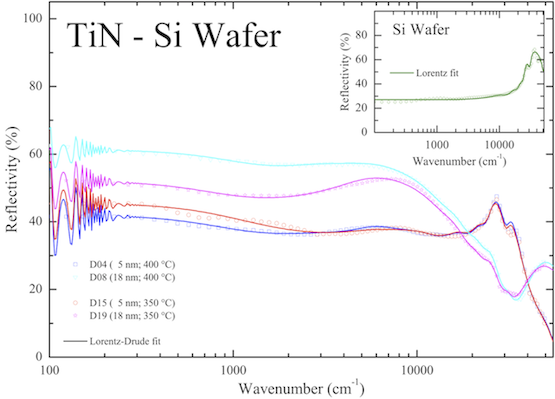Optical properties of TiN thin films close to the superconductor-insulator transition
The competition between localization and superconductivity can result in peculiar ground states. One of them is the so-called Bose-insulator, which is formed by localized Cooper pairs. It is a common notion that the superconducting ground state is characterized by long-range phase coherence and the possibility of non-dissipative charge transport. On the contrary, disorder acts in opposite direction, as it favors the repulsive part of the electron-electron interaction and the consequent localization of the electron wave function, so that the long-range phase coherence of the Cooper pairs is suppressed in the Bose-insulating state. At zero temperature the transition between these two phases, the so-called superconductor-insulator transition (SIT), is purely driven by quantum fluctuations and is the prime example of a quantum phase transition. Thin TiN films recently gained a lot of attention and seem to be well-suited for the study of these issues.

We performed reflectivity R(ω) measurements of the TiN multilayers structure from the far infrared up to the ultraviolet (UV) as a function of temperature (2-300 K). Figure 2.8 displays the R(ω) spectra at 300 K of our four multilayer specimens, while the inset shows the R(ω) measurement of the Si-wafer, acting as the substrate of the TiN thin films. The modelling of the TiN thin film within the Lorentz-Drude (LD) approach for a multilayer specimen supplies a tool for reconstructing its optical functions, assuming that there is no deviation of the thin film properties from the bulk material behavior. Panel a) of Fig. 2.9 displays the R(ω) spectra for the (hypothetical) situation of a bulk-like TiN specimen, while panel b) of Fig. 2.9 shows the resulting real part σ1(ω) of the optical conductivity. The inset in panel b) of Fig. 2.9 depicts the components of the fit, considered in order to achieve the best reproduction of the measured R(ω). Besides the Drude term there are several Lorentz h.o.'s defining the intrinsic shape of σ1(ω) for TiN in the infrared and visible spectral range.

There is a rather pronounced and broad mid-IR bump peaked at about 5000 cm-1, merging into the Drude contribution. The latter component emphasizes the metallic character of the TiN films. The mid-IR feature is very much reminiscent of similar excitations seen in a large variety of correlated materials, including the copper-oxide superconductors as well as the Kondo systems. For the time being, we may argue that the conduction band in TiN is about 104 cm-1 wide and that truly itinerant charge carriers, giving rise to the Drude component in σ1(ω), coexist with more (disorder-induced) localized charges at energy states below the mobility edge, giving then rise to the mid-IR pseudogap-like excitation.